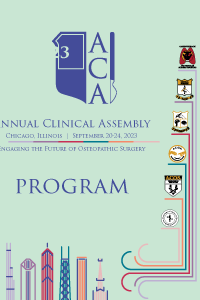
Young Son, D.O.
PGY 3
Jefferson New Jersey
Jefferson New Jersey
Philadelphia, Pennsylvania, United States
Primary Presenter(s)
Methods or Case Description:
The review protocol was registered in the PROSPERO (International Prospective Register of Systematic Review). A systematic review was performed in accordance with Preferred Reporting items for Systematic Reviews (PRISMA) guideline. We searched PubMed, Embase, Scopus, and Web of Science for systematic reviews evaluating articles for urological associated radiation knowledge, education, guidelines, safety, PPE, and procedural modification. Articles containing aforementioned criterias for practicing urologists or training urologists were included. Exclusion criteria included articles that were not written in English, case reviews, case reports, articles >10 years, and abstracts. Titles and abstracts of identified articles were reviewed by a methodologist with two independent reviewers screened for study eligibility. If there was a conflict between the two independent reviewers, a clinician adjudicator finalized the included studies. Risk-of-bias (RoB) assessment was performed independently by two authors using the cochrane RoB tool or validated Joanna Briggs Institute Critical Appraisal Checklist for non-randomized studies.
Outcomes: <strong id="docs-internal-guid-27f0dfa7-7fff-eaf9-cc90-e6e4c2ddc187" style="font-style: normal; font-variant-caps: normal; letter-spacing: normal; orphans: auto; text-align: start; text-indent: 0px; text-transform: none; white-space: normal; widows: auto; word-spacing: 0px; -webkit-text-stroke-width: 0px; text-decoration: none; caret-color: #000000; color: #000000; font-weight: normal;"><span style="font-size: 11pt; font-family: Arial; color: #000000; background-color: transparent; font-weight: 400; font-style: normal; font-variant-ligatures: normal; font-variant-caps: normal; font-variant-alternates: normal; font-variant-numeric: normal; font-variant-east-asian: normal; font-variant-position: normal; text-decoration: none; vertical-align: baseline; white-space: pre-wrap;">The electronic literature search yielded 209 unique citations regarding radiation association in urologists of which 45 articles were excluded as they were published greater than 10 years ago. Another 97 were excluded during abstract and title screening that did not meet the inclusion criteria. Through full manuscript review, additional 17 studies were excluded leaving a total of 50 studies meeting the inclusion criteria (figure). Of the 50 studies, 19 articles reported radiation risks to practicing urologist/residents, 10 articles reported radiation knowledge and compliance, 9 articles reported percutaneous nephrolithotomy (PCNL) specific safety measures, 2 articles reported retrograde intrarenal surgery (RIRS) specific safety measures, and 4 articles reported general radiation safety practices. The annual dose of lens radiation exposure averaged from 1.41- 3.73 mSV for high volume RIRS and PCNL surgeons. Thyroid exposure deepdose equivalent (DDE) was 335 mrems while the trunk doses averaged 3.63 mSV. Hand ring dosimeter in urological trainees total DDE was 2,250 mrems. An average of 10% of respondents was not familiar with the ALARA principle, 63%-66% had not received any type of radiation training, and >50% of participants did not have any information about harmful effects of radiation or preventive measures. Furthermore, the compliance of PPE was noted to be lowest for lead lined glasses worn by 3-5%-9% worn during surgery. Thyroid shields were worn by 40%-99% of practicing urologists and trainees. Almost all of the respondents (99%) wore lead aprons during endourological surgeries that required radiation. Lastly, the consistent use of dosimeters was documented at 10%-30%. <br /><br /><img src="https://www.abstractscorecard.com/b9f1e470-0495-4592-8275-e62c588f2996" /><br /></span></strong>
Conclusion: The long term effects of radiation to urologists are currently being investigated, however unknown at this time. The use of lead lined glasses, thyroid shields, lead gloves, and dosimeters was lowest in practicing urologists and residents. It is imperative to educate urology trainees on the techniques on reducing radiation exposure and utilization of fitted PPE should be the standard of care.

